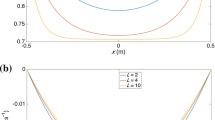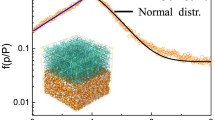Abstract
A theory of granular plasticity based on the time-averaged rigid-plastic flow equations is presented. Slow granular flows in hoppers are often modeled as rigid-plastic flows with frictional yield conditions. However, such constitutive relations lead to systems of partial differential equations that are ill-posed: they possess instabilities in the short-wavelength limit. In addition, features of these flows clearly depend on microstructure in a way not modeled by such continuum models. Here an attempt is made to address both short-comings by splitting variables into ‘fluctuating’ plus ‘average’ parts and time-averaging the rigid-plastic flow equations to produce effective equations which depend on the ‘average’ variables and variances of the ‘fluctuating’ variables. Microstructural physics can be introduced by appealing to the kinetic theory of inelastic hard-spheres to develop a constitutive relation for the new ‘fluctuating’ variables. The equations can then be closed by a suitable consitutive equation, requiring that this system of equations be stable in the short-wavelength limit. In this way a granular length-scale is introduced to the rigid-plastic flow equations.
Similar content being viewed by others
References
R.B. Thorpe, An experimental clue to the importance of dilation in determining the flow rate of a granular material from a hopper or bin.Chem. Engng. Sci. 47 (1992) 4295–4303.
A. Jenike, Gravity flow of bulk solids. Technical Report, Utah Engineering Experimental Station, University of Utah, Salt Lake City (1964).
R.M. Nedderman,Statics and Kinematics of Granular Materials. London: Cambridge University Press (1992) 368 pp.
P.-A. Gremaud and J.V. Matthews, On the computation of steady hopper flows: I, stress determination for coulomb materials. Technical Report CRSC TR99-35, Center for Research in Scientific Computing, North Carolina State University, Raleigh (1999).
D.G. Schaeffer, Instability in the evolution equations describing incompressible granular flow.J. Diff. Equ. 66 (1987) 19–50.
K.C. Valanis and J.F. Peters, Ill-posedness of the initial and boundary value problems in non-associative plasticity.Acta Mech. 114 (1996) 1–25.
S.B. Savage, The mechanics of rapid granular flows.Adv. Appl. Mech. 24 (1984) 289–366.
R.M. Nedderman and C. Laohakul, The thickness of the shear zone of flowing granular materials.Powder Technol. 25 (1980) 91–100.
H.-B. Muhlhaus and F. Oka, Dispersion and wave propagation in discrete and continuous models for granular materials.J. Solids Structs. 33 (1996) 2841–2858.
D.G. Schaeffer, Instability and ill-posedness in the deformation of granular materials.Int. J. Num. Anal. Methods Geomech. 14 (1990) 253–278.
J.T. Jenkins and S.B. Savage, A theory for the rapid flow of identical, smooth, nearly elastic, spherical particles.J. Fluid Mech. 130 (1983) 187–202.
S.B. Savage, Analysis of slow high-concentration flows of granular materials.J. Fluid Mech. 377 (1998) 1–26.
A. Drescher, On the criteria for mass flow in hoppers.Powder Technol. 73 (1992) 251–260.
L. Bocquet, W. Losert, D. Schalk, T.C. Lubensky and J.P. Gollub, Granular shear flow dynamics and forces: experiment and continuum theory.Phys. Rev. E 65 (2001) 011307.
Author information
Authors and Affiliations
Rights and permissions
About this article
Cite this article
Hendy, S.C. Towards a theory of granular plasticity. J Eng Math 52, 137–146 (2005). https://doi.org/10.1007/BF02694034
Received:
Accepted:
Issue Date:
DOI: https://doi.org/10.1007/BF02694034




